Editor: Nina
Researchers develop a nano parthenolide drug delivery system that improves intestinal barrier function in sepsis by inhibiting apoptosis and reactive oxygen species via the serotonin 2A receptor.
Key Preview
- Research Question: Can nano parthenolide (Nano PTL) improve intestinal barrier function in sepsis through the inhibition of apoptosis and reactive oxygen species (ROS) via 5-HTR2A?
- Research Design and Strategy: The study utilized a combination of in vivo and in vitro experiments on sepsis models (cecal ligation and puncture in rats and lipopolysaccharide-stimulated intestinal epithelial cells) to assess the effects of Nano PTL compared to ordinary parthenolide (PTL).
- Method: The encapsulation and uptake efficiency of Nano PTL were evaluated, followed by assessments of survival rates, inflammatory cytokine levels, and intestinal barrier function metrics.
- Key Results: Nano PTL significantly improved survival rates and time in septic rats, reduced inflammatory cytokines, enhanced intestinal barrier integrity, and exhibited superior efficacy compared to ordinary PTL.
- Significance of the Research: The findings suggest that Nano PTL may be a viable therapeutic strategy for protecting intestinal barrier function in sepsis, addressing a critical complication of the condition with limited treatment options.
Introduction
Sepsis is a life-threatening condition characterized by a dysregulated immune response to infection, leading to systemic inflammation and multi-organ dysfunction. It is a significant global health concern, affecting approximately 48.9 million individuals each year and resulting in mortality rates ranging from 20% to 30%. The pathophysiology of sepsis involves not only the initial infection but also the subsequent disruption of the intestinal barrier, which can lead to the translocation of gut bacteria and endotoxins into the bloodstream, exacerbating the inflammatory response and complicating the clinical course. As such, restoring and maintaining intestinal barrier integrity has become a critical aspect of sepsis management.
Traditional treatment strategies for sepsis typically focus on the administration of broad-spectrum antibiotics, fluid resuscitation, and supportive care to manage organ dysfunction. While these approaches are essential for controlling the immediate life-threatening aspects of sepsis, they often fail to address the underlying complications, particularly intestinal barrier dysfunction. This barrier dysfunction can result in persistent inflammation, increased infection risk, and ultimately higher mortality rates. Furthermore, conventional drug delivery methods are often hampered by issues such as poor bioavailability, limited solubility, and inadequate targeting of affected tissues, which can lead to suboptimal therapeutic outcomes.
The inherent challenges of current treatment strategies highlight the urgent need for innovative drug delivery systems that can enhance the effectiveness of therapeutic agents. One promising approach is the development of nano-formulated drugs, such as nano parthenolide (Nano PTL). By utilizing nanotechnology, drug delivery can be optimized to improve solubility, bioavailability, and targeted delivery to inflamed tissues. Nano PTL represents a novel strategy that not only aims to enhance the therapeutic efficacy of parthenolide but also addresses the critical issue of intestinal barrier dysfunction in sepsis. This innovative delivery system holds the potential to transform the management of sepsis by providing a more effective means of protecting the intestinal barrier and mitigating the severe complications associated with this complex condition.
Research Team and Aim
The research team was led by Ning-Ke Guo, an accomplished researcher affiliated with the Army Medical University in Chongqing, China. The study was conducted over a period that culminated in the publication of the paper titled “Nano Parthenolide Improves Intestinal Barrier Function of Sepsis by Inhibiting Apoptosis and ROS via 5-HTR2A.” This work was published in the International Journal of Nanomedicine.
The primary aim of the research, as articulated by the lead researcher, was to investigate the protective effects of nano parthenolide (Nano PTL) on intestinal barrier dysfunction in the context of sepsis and to elucidate the underlying mechanisms through which Nano PTL exerts its effects. Specifically, the study sought to determine whether Nano PTL could improve intestinal barrier integrity by inhibiting apoptosis and reactive oxygen species (ROS) production via modulation of the serotonin 2A receptor (5-HTR2A) signaling pathway.
Experimental Process
Experiment 1: Synthesis and Characterization of Nano PTL
Primary Technique: The primary technique employed in this experiment was the microemulsion method for synthesizing Nano Parthenolide (Nano PTL), which allows for the creation of nanosized drug carriers to enhance solubility and bioavailability.
Key Steps:
- Preparation of Ingredients: PTL was dissolved in medium-chain triglycerides (MCT) at a concentration suitable for synthesis.
- Combining Surfactants: Kolliphor HS-15 (surfactant) and polyethylene glycol (PEG-400: co-surfactant) were added to the MCT solution in a 4:2:1 (w/w/w) ratio.
- Stirring: The mixture was stirred using a magnetic stirrer at 300 rpm for 30 minutes at room temperature to ensure homogeneity.
- Dilution: The resulting solution was then diluted 100-fold with double-distilled water and stirred until a clear solution was obtained.
Data Collection and Analysis: Characterization of Nano PTL was performed using dynamic light scattering (DLS) to measure droplet size, zeta potential, and polydispersity index (PDI). Transmission electron microscopy (TEM) was utilized to visualize the morphology of the synthesized Nano PTL.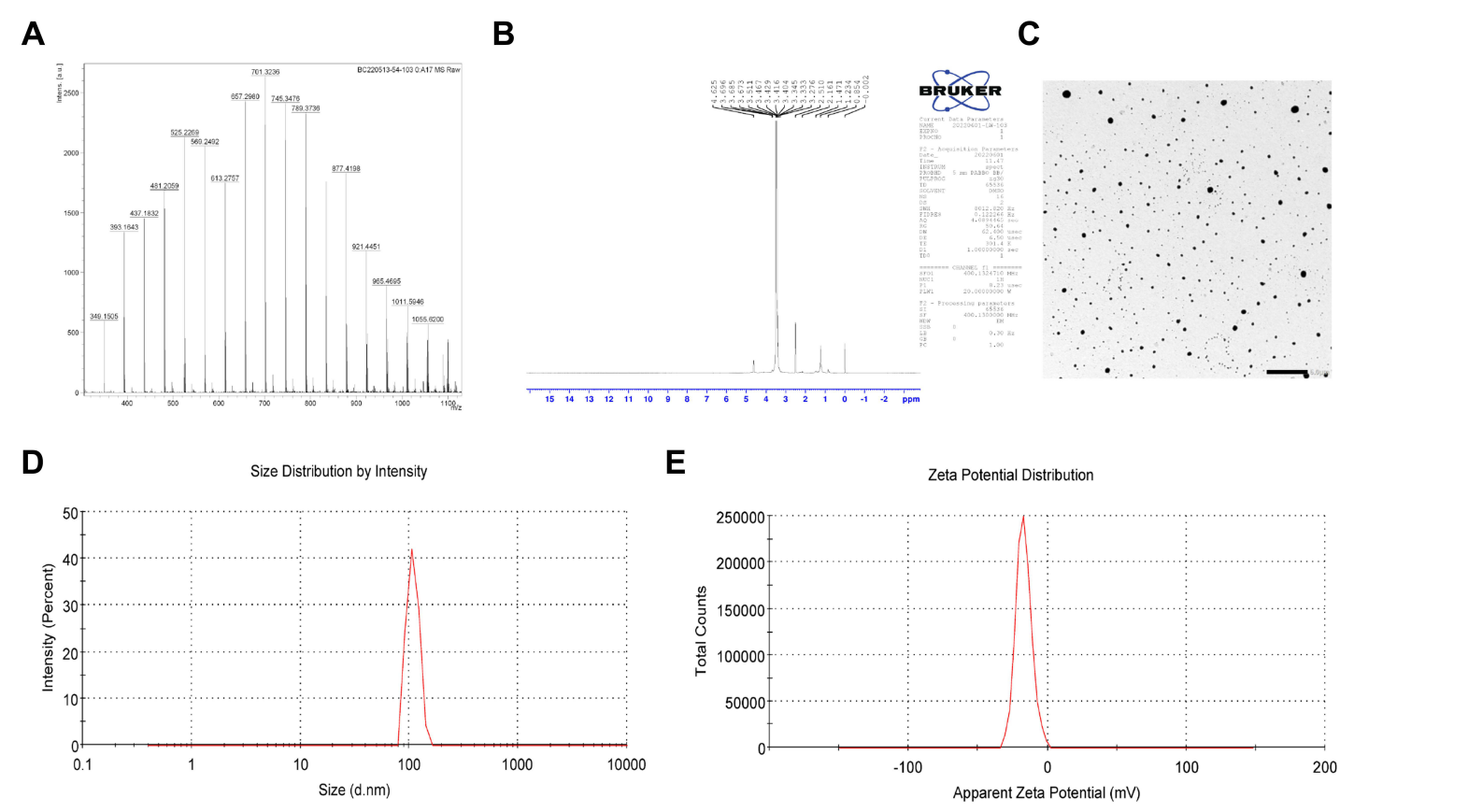
Figure 1. C) Representative image of TEM of Nano PTL (bar, 1 µm). (D) Size distribution of Nano PTL (n=3 independent experiments). (E) Zeta potential of Nano PTL (n=3 independent experiments).
Result: The synthesized Nano PTL exhibited an average particle size of 108.6 ± 0.8 nm, a zeta potential of −17 ± 0.6 mV, and an encapsulation efficiency of 95 ± 1.5%, indicating successful nanoformulation.
Novel Aspect: This study introduced a novel microemulsion technique for synthesizing Nano PTL, which significantly improved encapsulation efficiency and bioavailability compared to conventional delivery systems, showcasing its potential for enhanced therapeutic efficacy.
Experiment 2: Induction of Sepsis and Treatment in Animal Models
Primary Technique: The primary technique used in this experiment was the cecal ligation and puncture (CLP) model to induce sepsis in rats, allowing for the assessment of Nano PTL’s therapeutic effects in a live animal model.
Key Steps:
- Anesthesia: Adult SD rats (200-220 g) were anesthetized via intraperitoneal injection of sodium pentobarbital (45 mg/kg).
- Surgical Induction: The abdomen was surgically opened, the cecum was ligated, and a puncture was made to induce sepsis.
- Grouping: Rats were randomly divided into five groups: Normal control (Sham), Sepsis (Sep), Conventional Treatment (CT), Parthenolide (PTL), and Nano PTL.
- Treatment Administration: Twelve hours post-surgery, rats in the PTL and Nano PTL groups received treatments via tail vein injection (5 mg/kg).
Data Collection and Analysis: Survival rates were monitored at 48 hours, while mean arterial pressure (MAP) was recorded every 30 minutes using an arterial sphygmomanometer. Blood samples were collected for analysis of inflammatory cytokines using ELISA kits.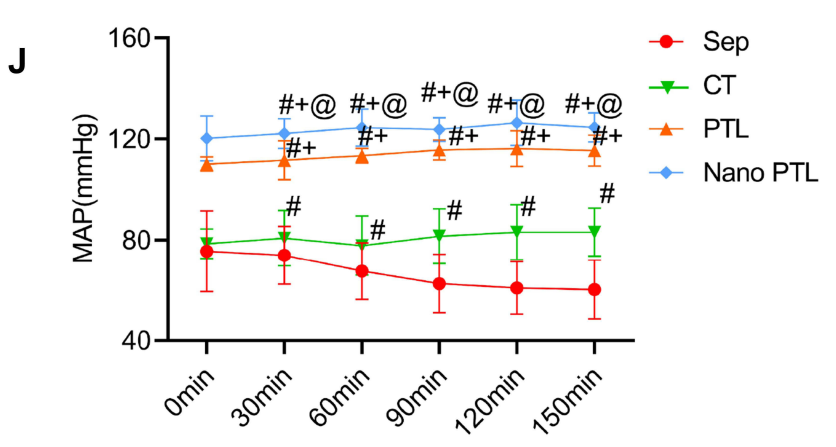
Figure 2. Mean arterial pressure of septic rats (n=8 per group). *P<0.05, compared with the Sham group. # P<0.05, compared with the Sep group. + P<0.05, compared with CT group. @P<0.05, compared with the PTL group.
Result: The Nano PTL group showed a 62.5% survival rate at 48 hours, significantly higher than the 43.6% for the PTL group and 12.5% for the CT group. Additionally, serum levels of IL-6, IL-1β, and TNF-α were significantly reduced in the Nano PTL group.
Novel Aspect: The use of Nano PTL demonstrated superior survival rates and reduction in inflammatory markers compared to traditional PTL treatment, indicating its potential as a more effective therapeutic agent in sepsis management.
Experiment 3: Evaluation of Intestinal Barrier Function
Primary Technique: The assessment of intestinal barrier function was conducted using the Evans Blue (EB) leakage test, complemented by histological examination through hematoxylin and eosin (HE) staining.
Key Steps:
- EB Administration: Following treatment, EB was administered to the rats, and intestinal samples were collected post-mortem.
- Sample Processing: The collected samples were prepared for absorbance measurement to quantify EB leakage.
- Histological Examination: Intestinal tissues were fixed in paraformaldehyde, sectioned, and stained with HE for morphological evaluation.
Data Collection and Analysis: EB concentration in intestinal tissues was measured using a spectrophotometer at 650 nm. Histological changes were assessed based on a scoring system evaluating epithelial integrity and inflammatory cell infiltration.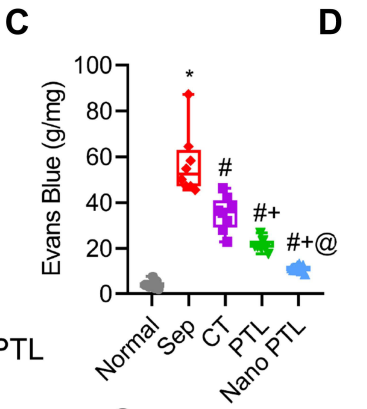
Figure 3. EB leakage of intestine after treated with Nano PTL (n=8 per group).
Result: EB leakage was significantly reduced by 68.6% in the Nano PTL group compared to the sepsis group, with HE staining revealing restored intestinal architecture in Nano PTL-treated rats.
Novel Aspect: The comprehensive assessment of intestinal barrier function using both EB leakage and histological evaluation provided robust evidence that Nano PTL preserves intestinal integrity, representing an advancement over traditional assessments that often focus on singular measures.
Experiment 4: In Vitro Assessment of Apoptosis and ROS Levels
Primary Technique: This experiment employed flow cytometry and Western blot analysis to evaluate the levels of apoptosis and reactive oxygen species (ROS) in lipopolysaccharide (LPS)-stimulated intestinal epithelial cells (IECs).
Key Steps:
- Cell Culture: IECs were cultured and then treated with LPS to induce apoptosis and oxidative stress.
- Drug Treatment: Cells were subsequently treated with either PTL or Nano PTL (1 µmol/L) for 2 hours.
- Flow Cytometry: Apoptotic cells were quantified using a FITC Annexin V Apoptosis Detection Kit, and ROS levels were assessed with a DCFH-DA kit.
Data Collection and Analysis: Flow cytometric data were analyzed to determine the percentage of apoptotic cells, while Western blot analysis was conducted to measure the expression levels of apoptosis-related proteins like Bax and cleaved-Caspase3.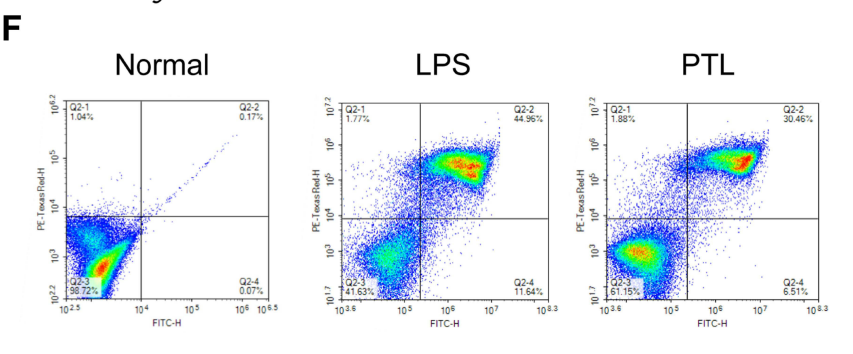
Figure 4. Flow cytometry of apoptosis.
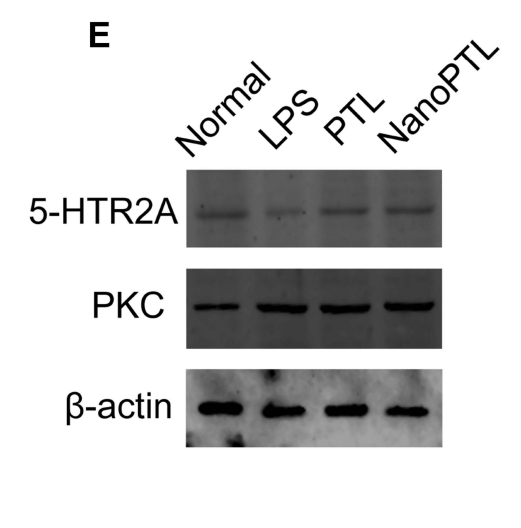
Figure 5. Western blot of 5-HTR2A and PKC in intestinal epithelial cells after treated with Nano PTL (n=3 independent experiments). (F and G) The relative expressions of 5-HTR2A and PKC (n=3 independent experiments). *P<0.05, compared with Normal. # P<0.05, compared with the LPS group. @P<0.05, compared with the PTL group.
Result: Nano PTL treatment significantly decreased both apoptosis rates (p < 0.05) and ROS levels compared to PTL treatment, indicating enhanced protective effects against oxidative stress.
Novel Aspect: The combination of flow cytometry and Western blotting provided a detailed mechanism of action for Nano PTL, showcasing its dual action in reducing oxidative stress and apoptosis, which is critical for addressing sepsis-related cellular damage.
Conclusion
The successful development of the nano parthenolide (Nano PTL) drug delivery system was achieved through a novel microemulsion synthesis technique that enhanced the encapsulation efficiency and bioavailability of parthenolide, allowing for targeted delivery to inflamed tissues in the context of sepsis. This innovative approach effectively addressed the limitations of traditional drug delivery methods, which often suffer from poor solubility and inadequate tissue targeting.
The highlights of the study include the significant improvement in survival rates and time in septic rats treated with Nano PTL compared to conventional treatments. Additionally, the research revealed that Nano PTL effectively reduced inflammatory cytokine levels and preserved intestinal barrier integrity by inhibiting apoptosis and reactive oxygen species (ROS) production through modulation of the serotonin 2A receptor (5-HTR2A) signaling pathway. These findings underscore the potential of Nano PTL as a promising therapeutic strategy for managing sepsis and its associated complications, marking a significant advancement in the field of nanomedicine.
Reference
Guo, Ning-Ke, et al. “Nano Parthenolide Improves Intestinal Barrier Function of Sepsis by Inhibiting Apoptosis and ROS via 5-HTR2A.” International Journal of Nanomedicine, vol. 18, 2023, pp. 693-709. doi:10.2147/IJN.S394544.
